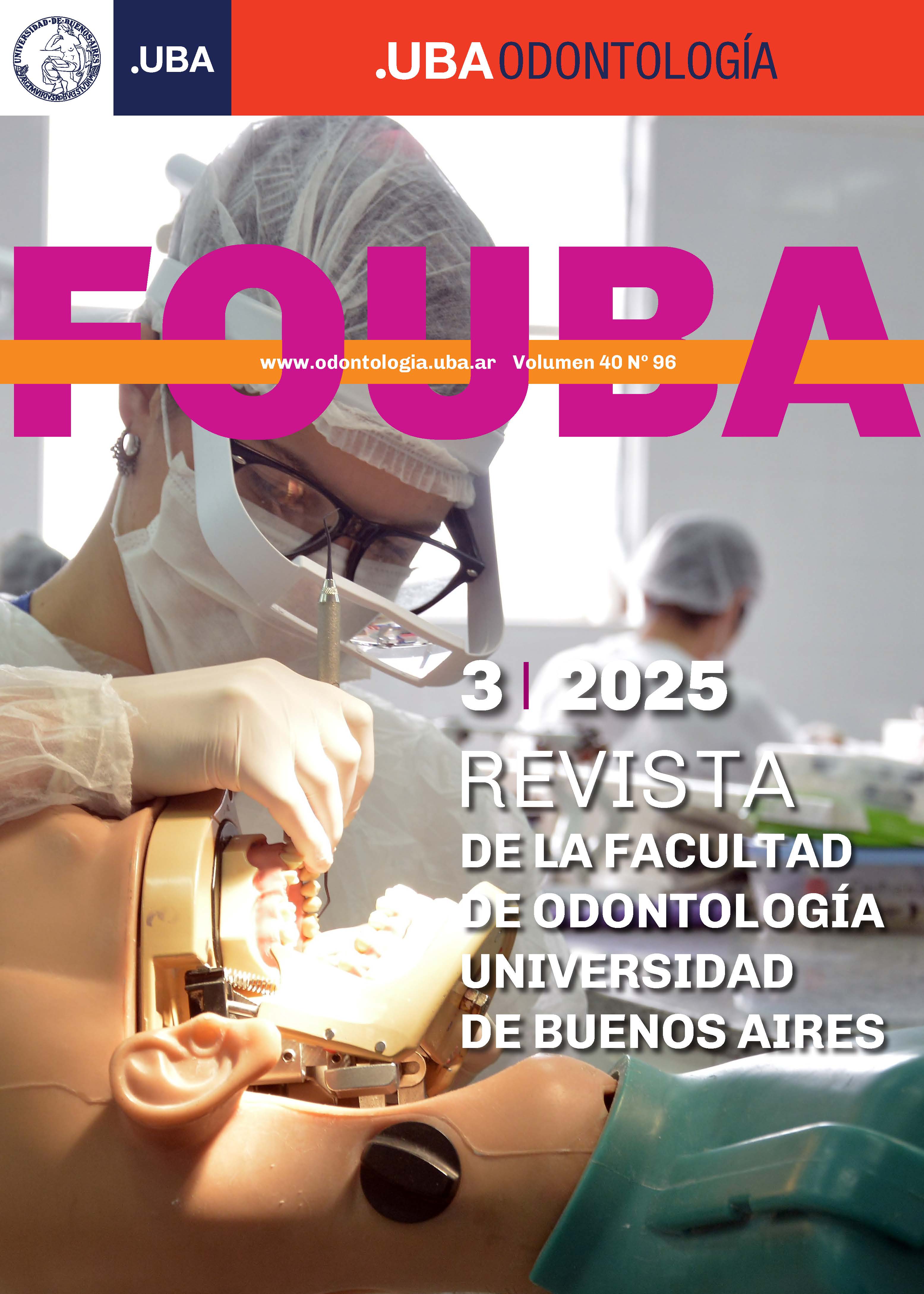Restauraciones Oclusales con Resinas Compuestas vs Resinas Bulk-fill en Dentición Primaria
Tiempo de Obturación y Desempeño Clínico
DOI:
https://doi.org/10.62172/revfouba.n96.a278Palabras clave:
Resinas compuestas, Diente primario, Longevidad, Estudio clínico, Caries dentalResumen
Las resinas compuestas presentan alta eficacia en la restauración de lesiones oclusales en la dentición primaria debido a su biocompatibilidad, adhesión y propiedades estéticas. Sin embargo, su aplicación mediante técnica incremental, sensible al manejo clínico y con mayores requerimientos de tiempo operatorio, puede dificultar su uso en pacientes pediátricos. Las resinas tipo bulk-fill fueron desarrolladas para simplificar los procedimientos restauradores, permitiendo inserciones en incrementos de mayor espesor, disminuyendo los pasos clínicos y reduciendo la posibilidad de contaminación, sin comprometer las propiedades físico-mecánicas. El objetivo de este estudio fue comparar el tiempo clínico requerido y la longevidad de restauraciones oclusales en molares primarios realizadas con resinas bulk-fill de alta viscosidad versus resinas compuestas nanohíbridas aplicadas con técnica incremental. Se diseñó un estudio experimental, longitudinal y prospectivo, aprobado por el Comité de Ética de FOUBA. Se incluyeron 26 pacientes de entre 5 y 9 años, en quienes se realizaron 58 restauraciones. Las restauraciones fueron evaluadas en situación basal, a los 6, 12 y 18 meses mediante los criterios RYGE/USPHS modificados. Los resultados mostraron que el grupo restaurado con resina bulk-fill presentó un tiempo clínico significativamente menor (63% más rápido, p=0,000), sin diferencias significativas en el desempeño clínico respecto al grupo con técnica incremental. Se concluyó que la principal ventaja del uso de resinas bulk-fill de alta viscosidad fue la reducción del tiempo operatorio, demostrando un desempeño clínico similar al de las resinas convencionales en dientes primarios, sin diferencias significativas en los parámetros evaluados.
Citas
Afshari, E., Sabbagh, S., Khorakian, F., Sarraf Shirazi, A., y Akbarzadeh Baghban, A. (2023). Reducing pain and discomfort associated with rubber dam clamp placement in children and adolescents: a systematic review and meta-analysis of effectiveness. BMC Oral Health, 23(1), 398. https://doi.org/10.1186/s12903-023-03115-7
Akah, M. M., Daifalla, L. E., y Yousry, M. M. (2016). Bonding of bulk fill versus contemporary resin composites: A systematic review and meta-analysis. Indian Journal of Science and Technology, 9(20), 1–13. https://doi.org/10.17485/ijst/2016/v9i20/90525
Arbildo-Vega, H. I., Lapinska, B., Panda, S., Lamas-Lara, C., Khan, A. S., y Lukomska-Szymanska, M. (2020). Clinical effectiveness of bulk-fill and conventional resin composite restorations: systematic review and meta-analysis. Polymers, 12(8), 1786. https://doi.org/10.3390/polym12081786
Bellinaso, M. D., Soares, F. Z. M., y Rocha, R. O. (2019). Do bulk-fill resins decrease the restorative time in posterior teeth? A systematic review and meta-analysis of in vitro studies. Journal of Investigative and Clinical Dentistry, 10(4), e12463. https://doi.org/10.1111/jicd.12463
Chaple Gil, A. M. (2015). Comparación de dos clasificaciones de preparaciones cavitarias y lesiones cariosas: Mount y Hume, y Black. Revista Cubana de Estomatología, 52(2), 160─170. http://scielo.sld.cu/scielo.php?script=sci_arttext&pid=S0034-75072015000200005
Chisini, L. A., Collares, K., Cademartori, M. G., de Oliveira, L. J. C., Conde, M. C. M., Demarco, F. F., y Corrêa, M. B. (2018). Restorations in primary teeth: a systematic review on survival and reasons for failures. International Journal of Paediatric Dentistry, 28(2), 123–139. https://doi.org/10.1111/ipd.12346
Davidovich, E., Wated, A., Shapira, J., y Ram, D. (2013). The influence of location of local anesthesia and complexity/duration of restorative treatment on children's behavior during dental treatment. Pediatric Dentistry, 35(4), 333–336. https://www.ingentaconnect.com/content/aapd/pd/2013/00000035/00000004/art00006
Delgado, A. H. S., Jamal, H., Young, A., y Ashley, P. (2021). Scoping review of trials evaluating adhesive strategies in pediatric dentistry: where do simplified strategies lie?. BMC Oral Health, 21(1), 33. https://doi.org/10.1186/s12903-021-01395-5
Dhar, V., Hsu, K. L., Coll, J. A., Ginsberg, E., Ball, B. M., Chhibber, S., Johnson, M., Kim, M., Modaresi, N., y Tinanoff, N. (2015). Evidence-based update of pediatric dental restorative procedures: dental materials. The Journal of Clinical Pediatric Dentistry, 39(4), 303–310. https://doi.org/10.17796/1053-4628-39.4.303
Donly, K. J., y García-Godoy, F. (2015). The use of resin-based composite in children: an update. Pediatric Dentistry, 37(2), 136–143. https://www.ingentaconnect.com/content/aapd/pd/2015/00000037/00000002/art00008
Fröhlich, T. T., Gindri, L. D., Soares, F. Z. M., y de Oliveira Rocha, R. (2021). Does the etching strategy influence the bonding of universal adhesive systems to primary teeth? A systematic review and meta-analysis of in vitro studies. European Archives of Paediatric Dentistry, 22(6), 1015–1022. https://doi.org/10.1007/s40368-021-00639-w
Gindri, L. D., Cassol, I. P., Fröhlich, T. T., y Rocha, R. O. (2022). One-year clinical evaluation of class II bulk-fill restorations in primary molars: a randomized clinical trial. Brazilian Dental Journal, 33(6), 110–120. https://doi.org/10.1590/0103-6440202205069
Heck, K., Manhart, J., Hickel, R., y Diegritz, C. (2018). Clinical evaluation of the bulk fill composite QuiXfil in molar class I and II cavities: 10-year results of a RCT. Dental Materials, 34(6), e138–e147. https://doi.org/10.1016/j.dental.2018.03.023
Jamali, Z., Najafpour, E., Ebrahim Adhami, Z., Sighari Deljavan, A., Aminabadi, N. A., y Shirazi, S. (2018). Does the length of dental procedure influence children's behavior during and after treatment? A systematic review and critical appraisal. Journal of Dental Research, Dental Clinics, Dental Prospects, 12(1), 68–76. https://doi.org/10.15171/joddd.2018.011
Katre A. N. (2014). Assessment of the correlation between appointment scheduling and patient satisfaction in a pediatric dental setup. International Journal of Dentistry, 2014, 453237. https://doi.org/10.1155/2014/453237
Kunz, P. V. M., Wambier, L. M., Kaizer, M. D. R., Correr, G. M., Reis, A., y Gonzaga, C. C. (2022). Is the clinical performance of composite resin restorations in posterior teeth similar if restored with incremental or bulk-filling techniques? A systematic review and meta-analysis. Clinical Oral Investigations, 26(3), 2281–2297. https://doi.org/10.1007/s00784-021-04337-1
Leinonen, K. M., Leinonen, J., Bolstad, N. L., Tanner, T., Al-Haroni, M., y Johnsen, J. K. (2023). Procedure time and filling quality for bulk-fill base and conventional incremental composite techniques-A randomised controlled in vitro trial. Journal of Dentistry, 138, 104725. https://doi.org/10.1016/j.jdent.2023.104725
Metz, I., Rothmaier, K., Pitchika, V., Crispin, A., Hickel, R., Garcia-Godoy, F., Bücher, K., y Kühnisch, J. (2015). Risk factors for secondary caries in direct composite restorations in primary teeth. International Journal of Paediatric Dentistry, 25(6), 451–461. https://doi.org/10.1111/ipd.12157
Mount, G. J., y Hume, W. R. (1998). A new cavity classification. Australian Dental Journal, 43(3), 153–159. https://doi.org/10.1111/j.1834-7819.1998.tb00156.x
Neves, A. B., da Matta Lessa, A. C., Frazão Câmara, J. V., Vaz Braga Pintor, A., y de Almeida Neves, A. (2018). Bulk-fill resins in pediatric dentistry: case reports with six-month follow-up. Revista Científica do CRO-RJ (Rio de Janeiro Dental Journal), 3(2), 65–71. https://revcientifica.cro-rj.org.br/revista/article/view/31
Ortolani, A. M., Cortese, S. G., y Biondi, A. M. (2016). Comparación clínica de sistemas adhesivos con grabado selectivo en piezas primarias. Revista de la Facultad de Odontología. Universidad de Buenos Aires, 31(71). 27–33. https://repositorio.odontologia.uba.ar/items/show/1357
Öter, B., Deniz, K., y Cehreli, S. B. (2018). Preliminary data on clinical performance of bulk-fill restorations in primary molars. Nigerian Journal of Clinical Practice, 21(11), 1484–1491. https://doi.org/10.4103/njcp.njcp_151_18
Paganini, A., Attin, T., y Tauböck, T. T. (2020). Margin integrity of bulk-fill composite restorations in primary teeth. Materials (Basel, Switzerland), 13(17), 3802. https://doi.org/10.3390/ma13173802
Ribeiro, J. F., Forgerini, T. V., Pedrotti, D., Rocha, R. O., Ardenghi, T. M., Soares, F. Z. M., y Lenzi, T. L. (2018). Performance of resin composite restorations in the primary dentition: a retrospective university-based study. International Journal of Paediatric Dentistry, 10.1111/ipd.12404. Advance online publication. https://doi.org/10.1111/ipd.12404
Rojas-Padilla, S. V. y Ríos-Caro, T. E. (2021). Microfiltración marginal de resinas de relleno masivo y nanohíbrida en molares deciduos. Revista Cubana de Estomatología, 58(2). http://scielo.sld.cu/scielo.php?script=sci_arttext&pid=S0034-75072021000200007
Sarapultseva, M., y Sarapultsev, A. (2019). Flowable bulk-fill materials compared to nano ceramic composites for Class I cavities restorations in primary molars: a two-year prospective case-control study. Dentistry Journal, 7(4), 94. https://doi.org/10.3390/dj7040094
Sengupta, A., Naka, O., Mehta, S. B., y Banerji, S. (2023). The clinical performance of bulk-fill versus the incremental layered application of direct resin composite restorations: a systematic review. Evidence-Based Dentistry, 24(3), 143. https://doi.org/10.1038/s41432-023-00905-4
Silva, G., Marto, C. M., Amaro, I., Coelho, A., Sousa, J., Ferreira, M. M., Francisco, I., Vale, F., Oliveiros, B., Carrilho, E., y Paula, A. B. (2023). Bulk-fill resins versus conventional resins: an umbrella review. Polymers, 15(12), 2613. https://doi.org/10.3390/polym15122613
Vianna-de-Pinho, M. G., Rego, G. F., Vidal, M. L., Alonso, R. C. B., Schneider, L. F. J., y Cavalcante, L. M. (2017). Clinical time required and internal adaptation in cavities restored with bulk-fill composites. The Journal of Contemporary Dental Practice, 18(12), 1107–1111. https://doi.org/10.5005/jp-journals-10024-2184
Zorzin, J., Maier, E., Harre, S., Fey, T., Belli, R., Lohbauer, U., Petschelt, A., y Taschner, M. (2015). Bulk-fill resin composites: polymerization properties and extended light curing. Dental Materials, 31(3), 293–301. https://doi.org/10.1016/j.dental.2014.12.010
Publicado
Cómo citar
Número
Sección
Licencia
Derechos de autor 2025 Revista de la Facultad de Odontologia. Universidad de Buenos Aires

Esta obra está bajo una licencia internacional Creative Commons Atribución-NoComercial-SinDerivadas 4.0.











